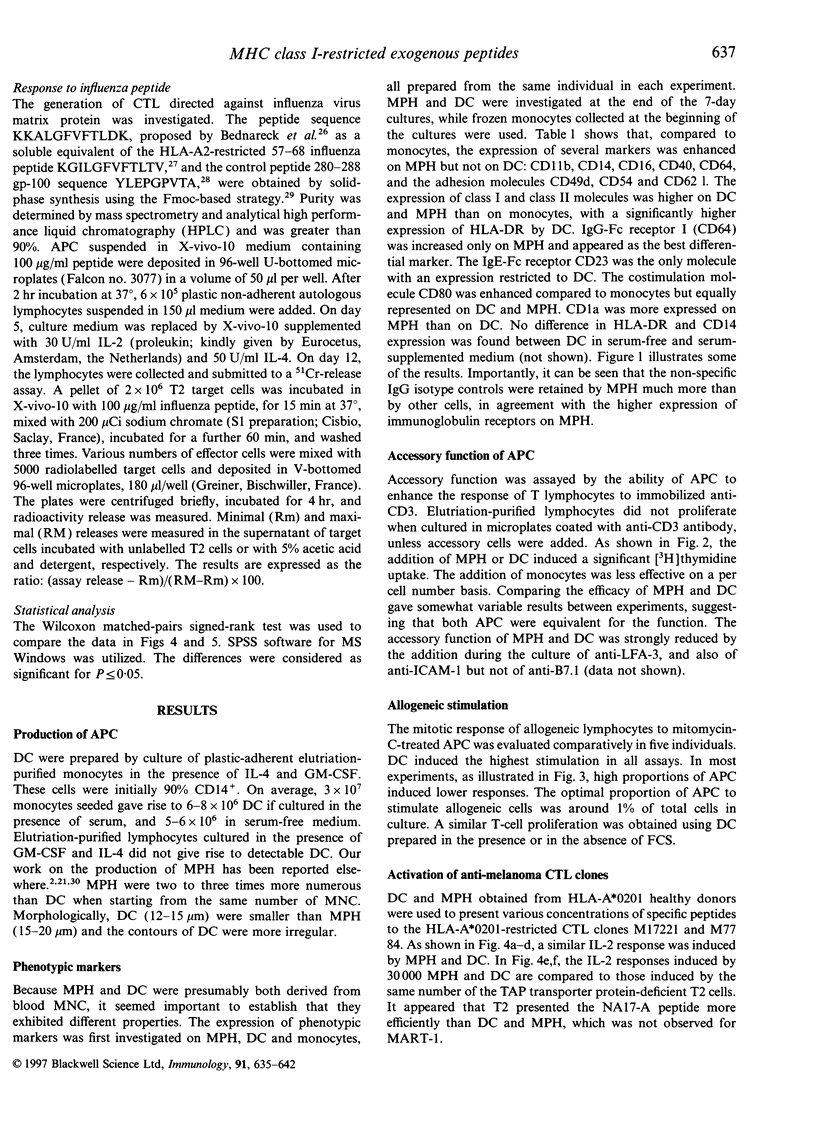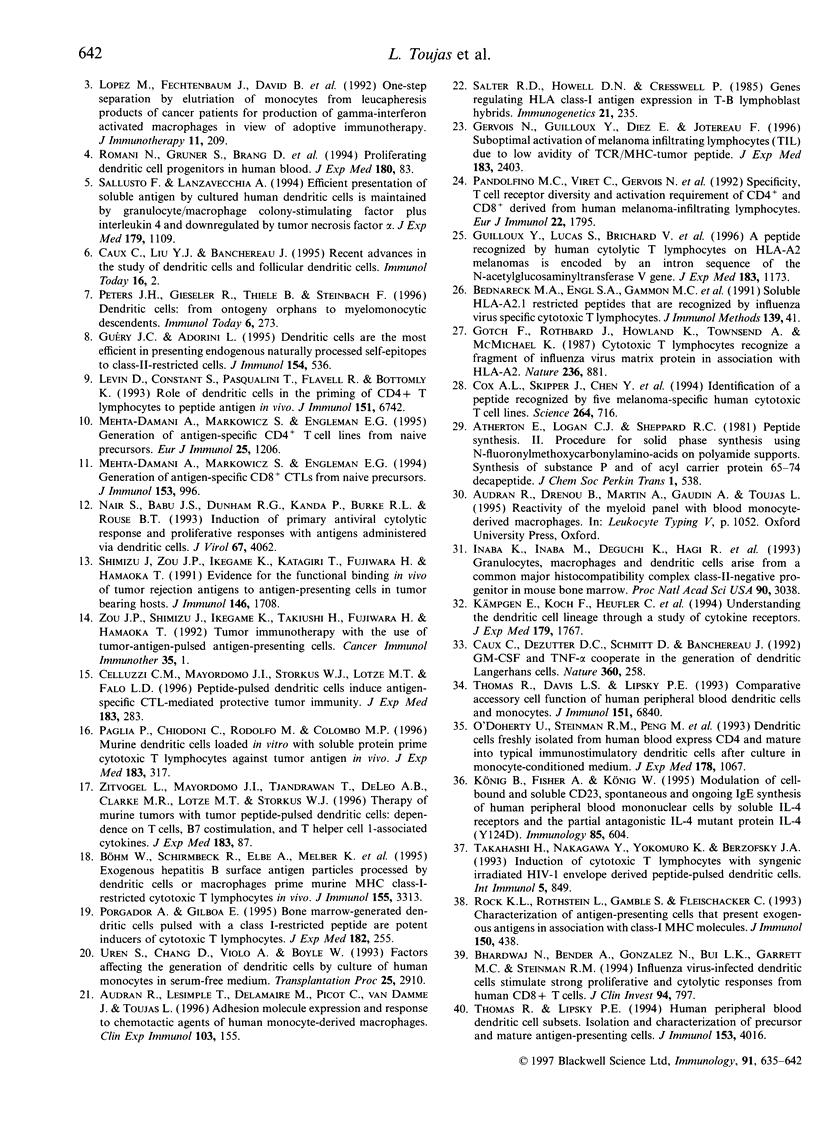Abstract
Recent experimental data have shown that mice could be immunized efficiently, in particular against cancer, by the injection of antigen-loaded dendritic cells (DC) or macrophages (MPH). In the present work, these two antigen-presenting cells (APC) were prepared in humans from circulating mononuclear cells (MNC). MPH were obtained from MNC that were cultured in hydrophobic plastic bags and purified by elutriation. DC were from the culture of adherent elutriation-purified monocytes in the presence of granulocyte-macrophage colony-stimulating factor (GM-CSF) and interleukin-4 (IL-4). The two APC were prepared in parallel from the same donors and their phenotype and antigen-presenting capacity were compared. DC differed from MPH by a higher expression of HLA-DR and CD23 and a lower expression of CD14, CD64 and of adhesion molecules. DC and MPH were comparably effective in (a) enhancing the mitotic response of autologous lymphocytes to immobilized anti-CD3 (accessory function); (b) presenting melanoma peptides to specific cytotoxic T lymphocyte (CTL) clones; and (c) stimulating the generation of CTL directed against a myxovirus influenza peptide. However, DC were more effective than MPH in inducing the mitotic response of allogeneic peripheral blood leucocytes (PBL), possibly because of their higher expression of HLA class II molecules. In conclusion, DC and MPH prepared from blood MNC did not differ substantially in their ability to activate HLA class I-restricted T-cell responses by exogenous peptide presentation.
Full text
PDF







Selected References
These references are in PubMed. This may not be the complete list of references from this article.
- Andreesen R., Scheibenbogen C., Brugger W., Krause S., Meerpohl H. G., Leser H. G., Engler H., Löhr G. W. Adoptive transfer of tumor cytotoxic macrophages generated in vitro from circulating blood monocytes: a new approach to cancer immunotherapy. Cancer Res. 1990 Dec 1;50(23):7450–7456. [PubMed] [Google Scholar]
- Audran R., Drenou B., Wittke F., Gaudin A., Lesimple T., Toujas L. Internalization of human macrophage surface antigens induced by monoclonal antibodies. J Immunol Methods. 1995 Dec 15;188(1):147–154. doi: 10.1016/0022-1759(95)00213-8. [DOI] [PubMed] [Google Scholar]
- Audran R., Lesimple T., Delamaire M., Picot C., Van Damme J., Toujas L. Adhesion molecule expression and response to chemotactic agents of human monocyte-derived macrophages. Clin Exp Immunol. 1996 Jan;103(1):155–160. doi: 10.1046/j.1365-2249.1996.d01-4.x. [DOI] [PMC free article] [PubMed] [Google Scholar]
- Bednarek M. A., Engl S. A., Gammon M. C., Lindquist J. A., Porter G., Williamson A. R., Zweerink H. J. Soluble HLA-A2.1 restricted peptides that are recognized by influenza virus specific cytotoxic T lymphocytes. J Immunol Methods. 1991 May 17;139(1):41–47. doi: 10.1016/0022-1759(91)90349-k. [DOI] [PubMed] [Google Scholar]
- Bhardwaj N., Bender A., Gonzalez N., Bui L. K., Garrett M. C., Steinman R. M. Influenza virus-infected dendritic cells stimulate strong proliferative and cytolytic responses from human CD8+ T cells. J Clin Invest. 1994 Aug;94(2):797–807. doi: 10.1172/JCI117399. [DOI] [PMC free article] [PubMed] [Google Scholar]
- Böhm W., Schirmbeck R., Elbe A., Melber K., Diminky D., Kraal G., van Rooijen N., Barenholz Y., Reimann J. Exogenous hepatitis B surface antigen particles processed by dendritic cells or macrophages prime murine MHC class I-restricted cytotoxic T lymphocytes in vivo. J Immunol. 1995 Oct 1;155(7):3313–3321. [PubMed] [Google Scholar]
- Caux C., Dezutter-Dambuyant C., Schmitt D., Banchereau J. GM-CSF and TNF-alpha cooperate in the generation of dendritic Langerhans cells. Nature. 1992 Nov 19;360(6401):258–261. doi: 10.1038/360258a0. [DOI] [PubMed] [Google Scholar]
- Celluzzi C. M., Mayordomo J. I., Storkus W. J., Lotze M. T., Falo L. D., Jr Peptide-pulsed dendritic cells induce antigen-specific CTL-mediated protective tumor immunity. J Exp Med. 1996 Jan 1;183(1):283–287. doi: 10.1084/jem.183.1.283. [DOI] [PMC free article] [PubMed] [Google Scholar]
- Cox A. L., Skipper J., Chen Y., Henderson R. A., Darrow T. L., Shabanowitz J., Engelhard V. H., Hunt D. F., Slingluff C. L., Jr Identification of a peptide recognized by five melanoma-specific human cytotoxic T cell lines. Science. 1994 Apr 29;264(5159):716–719. doi: 10.1126/science.7513441. [DOI] [PubMed] [Google Scholar]
- Gervois N., Guilloux Y., Diez E., Jotereau F. Suboptimal activation of melanoma infiltrating lymphocytes (TIL) due to low avidity of TCR/MHC-tumor peptide interactions. J Exp Med. 1996 May 1;183(5):2403–2407. doi: 10.1084/jem.183.5.2403. [DOI] [PMC free article] [PubMed] [Google Scholar]
- Gotch F., Rothbard J., Howland K., Townsend A., McMichael A. Cytotoxic T lymphocytes recognize a fragment of influenza virus matrix protein in association with HLA-A2. 1987 Apr 30-May 6Nature. 326(6116):881–882. doi: 10.1038/326881a0. [DOI] [PubMed] [Google Scholar]
- Guilloux Y., Lucas S., Brichard V. G., Van Pel A., Viret C., De Plaen E., Brasseur F., Lethé B., Jotereau F., Boon T. A peptide recognized by human cytolytic T lymphocytes on HLA-A2 melanomas is encoded by an intron sequence of the N-acetylglucosaminyltransferase V gene. J Exp Med. 1996 Mar 1;183(3):1173–1183. doi: 10.1084/jem.183.3.1173. [DOI] [PMC free article] [PubMed] [Google Scholar]
- Guéry J. C., Adorini L. Dendritic cells are the most efficient in presenting endogenous naturally processed self-epitopes to class II-restricted T cells. J Immunol. 1995 Jan 15;154(2):536–544. [PubMed] [Google Scholar]
- Inaba K., Inaba M., Deguchi M., Hagi K., Yasumizu R., Ikehara S., Muramatsu S., Steinman R. M. Granulocytes, macrophages, and dendritic cells arise from a common major histocompatibility complex class II-negative progenitor in mouse bone marrow. Proc Natl Acad Sci U S A. 1993 Apr 1;90(7):3038–3042. doi: 10.1073/pnas.90.7.3038. [DOI] [PMC free article] [PubMed] [Google Scholar]
- Kämpgen E., Koch F., Heufler C., Eggert A., Gill L. L., Gillis S., Dower S. K., Romani N., Schuler G. Understanding the dendritic cell lineage through a study of cytokine receptors. J Exp Med. 1994 Jun 1;179(6):1767–1776. doi: 10.1084/jem.179.6.1767. [DOI] [PMC free article] [PubMed] [Google Scholar]
- König B., Fischer A., König W. Modulation of cell-bound and soluble CD23, spontaneous and ongoing IgE synthesis of human peripheral blood mononuclear cells by soluble IL-4 receptors and the partial antagonistic IL-4 mutant protein IL-4 (Y124D). Immunology. 1995 Aug;85(4):604–610. [PMC free article] [PubMed] [Google Scholar]
- Levin D., Constant S., Pasqualini T., Flavell R., Bottomly K. Role of dendritic cells in the priming of CD4+ T lymphocytes to peptide antigen in vivo. J Immunol. 1993 Dec 15;151(12):6742–6750. [PubMed] [Google Scholar]
- Mehta-Damani A., Markowicz S., Engleman E. G. Generation of antigen-specific CD4+ T cell lines from naive precursors. Eur J Immunol. 1995 May;25(5):1206–1211. doi: 10.1002/eji.1830250511. [DOI] [PubMed] [Google Scholar]
- Mehta-Damani A., Markowicz S., Engleman E. G. Generation of antigen-specific CD8+ CTLs from naive precursors. J Immunol. 1994 Aug 1;153(3):996–1003. [PubMed] [Google Scholar]
- Nair S., Babu J. S., Dunham R. G., Kanda P., Burke R. L., Rouse B. T. Induction of primary, antiviral cytotoxic, and proliferative responses with antigens administered via dendritic cells. J Virol. 1993 Jul;67(7):4062–4069. doi: 10.1128/jvi.67.7.4062-4069.1993. [DOI] [PMC free article] [PubMed] [Google Scholar]
- O'Doherty U., Steinman R. M., Peng M., Cameron P. U., Gezelter S., Kopeloff I., Swiggard W. J., Pope M., Bhardwaj N. Dendritic cells freshly isolated from human blood express CD4 and mature into typical immunostimulatory dendritic cells after culture in monocyte-conditioned medium. J Exp Med. 1993 Sep 1;178(3):1067–1076. doi: 10.1084/jem.178.3.1067. [DOI] [PMC free article] [PubMed] [Google Scholar]
- Paglia P., Chiodoni C., Rodolfo M., Colombo M. P. Murine dendritic cells loaded in vitro with soluble protein prime cytotoxic T lymphocytes against tumor antigen in vivo. J Exp Med. 1996 Jan 1;183(1):317–322. doi: 10.1084/jem.183.1.317. [DOI] [PMC free article] [PubMed] [Google Scholar]
- Pandolfino M. C., Viret C., Gervois N., Guilloux Y., Davodeau F., Diez E., Jotereau F. Specificity, T cell receptor diversity and activation requirements of CD4+ and CD8+ clones derived from human melanoma-infiltrating lymphocytes. Eur J Immunol. 1992 Jul;22(7):1795–1802. doi: 10.1002/eji.1830220719. [DOI] [PubMed] [Google Scholar]
- Peters J. H., Gieseler R., Thiele B., Steinbach F. Dendritic cells: from ontogenetic orphans to myelomonocytic descendants. Immunol Today. 1996 Jun;17(6):273–278. doi: 10.1016/0167-5699(96)80544-5. [DOI] [PubMed] [Google Scholar]
- Porgador A., Gilboa E. Bone marrow-generated dendritic cells pulsed with a class I-restricted peptide are potent inducers of cytotoxic T lymphocytes. J Exp Med. 1995 Jul 1;182(1):255–260. doi: 10.1084/jem.182.1.255. [DOI] [PMC free article] [PubMed] [Google Scholar]
- Rock K. L., Rothstein L., Gamble S., Fleischacker C. Characterization of antigen-presenting cells that present exogenous antigens in association with class I MHC molecules. J Immunol. 1993 Jan 15;150(2):438–446. [PubMed] [Google Scholar]
- Romani N., Gruner S., Brang D., Kämpgen E., Lenz A., Trockenbacher B., Konwalinka G., Fritsch P. O., Steinman R. M., Schuler G. Proliferating dendritic cell progenitors in human blood. J Exp Med. 1994 Jul 1;180(1):83–93. doi: 10.1084/jem.180.1.83. [DOI] [PMC free article] [PubMed] [Google Scholar]
- Sallusto F., Lanzavecchia A. Efficient presentation of soluble antigen by cultured human dendritic cells is maintained by granulocyte/macrophage colony-stimulating factor plus interleukin 4 and downregulated by tumor necrosis factor alpha. J Exp Med. 1994 Apr 1;179(4):1109–1118. doi: 10.1084/jem.179.4.1109. [DOI] [PMC free article] [PubMed] [Google Scholar]
- Salter R. D., Howell D. N., Cresswell P. Genes regulating HLA class I antigen expression in T-B lymphoblast hybrids. Immunogenetics. 1985;21(3):235–246. doi: 10.1007/BF00375376. [DOI] [PubMed] [Google Scholar]
- Shimizu J., Zou J. P., Ikegame K., Katagiri T., Fujiwara H., Hamaoka T. Evidence for the functional binding in vivo of tumor rejection antigens to antigen-presenting cells in tumor-bearing hosts. J Immunol. 1991 Mar 1;146(5):1708–1714. [PubMed] [Google Scholar]
- Takahashi H., Nakagawa Y., Yokomuro K., Berzofsky J. A. Induction of CD8+ cytotoxic T lymphocytes by immunization with syngeneic irradiated HIV-1 envelope derived peptide-pulsed dendritic cells. Int Immunol. 1993 Aug;5(8):849–857. doi: 10.1093/intimm/5.8.849. [DOI] [PubMed] [Google Scholar]
- Thomas R., Davis L. S., Lipsky P. E. Comparative accessory cell function of human peripheral blood dendritic cells and monocytes. J Immunol. 1993 Dec 15;151(12):6840–6852. [PubMed] [Google Scholar]
- Thomas R., Lipsky P. E. Human peripheral blood dendritic cell subsets. Isolation and characterization of precursor and mature antigen-presenting cells. J Immunol. 1994 Nov 1;153(9):4016–4028. [PubMed] [Google Scholar]
- Uren S., Chang D., Violo A., Boyle W. Factors affecting the generation of dendritic cells by culture of human monocytes in serum-free medium. Transplant Proc. 1993 Oct;25(5):2910–2912. [PubMed] [Google Scholar]
- Zitvogel L., Mayordomo J. I., Tjandrawan T., DeLeo A. B., Clarke M. R., Lotze M. T., Storkus W. J. Therapy of murine tumors with tumor peptide-pulsed dendritic cells: dependence on T cells, B7 costimulation, and T helper cell 1-associated cytokines. J Exp Med. 1996 Jan 1;183(1):87–97. doi: 10.1084/jem.183.1.87. [DOI] [PMC free article] [PubMed] [Google Scholar]
- Zou J. P., Shimizu J., Ikegame K., Takiuchi H., Fujiwara H., Hamaoka T. Tumor-immunotherapy with the use of tumor-antigen-pulsed antigen-presenting cells. Cancer Immunol Immunother. 1992;35(1):1–6. doi: 10.1007/BF01741047. [DOI] [PMC free article] [PubMed] [Google Scholar]


